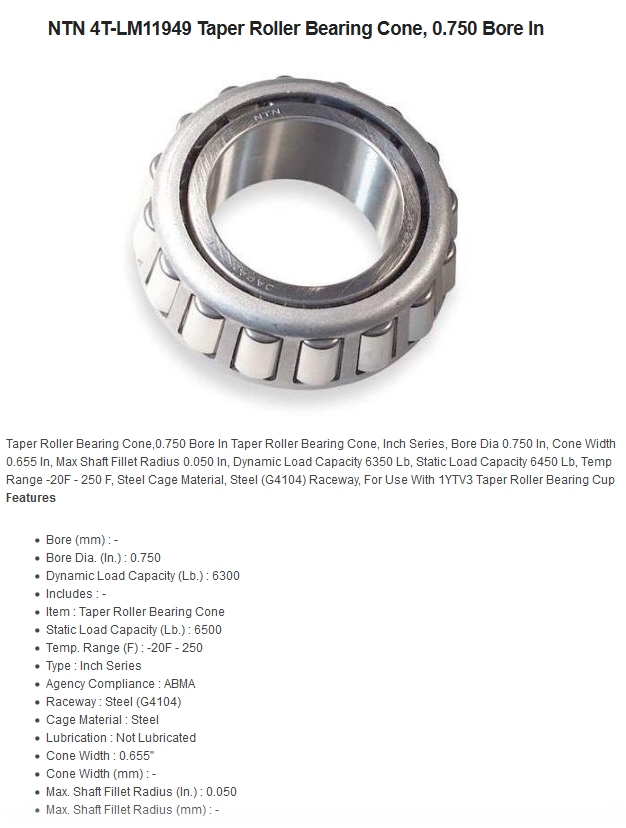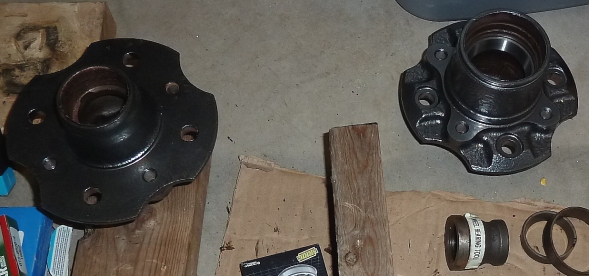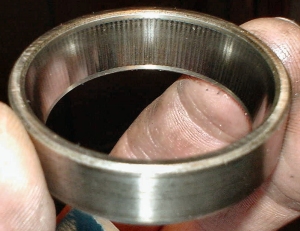
Figure 1. Front Wheel Bearing (Seal, Inner, and Outer)
Front Wheel Bearing (240z, 260z, 280z)

Figure 1. Front Wheel Bearing (Seal, Inner,
and Outer)
Overview
Drawings

Figure 2. Front Wheel Bearing (Detail)

Figure 3. Front Wheel Bearing & Wheel (Cross
Section)
Nissan Part Numbers
Replacement Parts

Figure 4. Front Wheel Bearing Outer Bearing
NTN LT-LM11949

Figure 6. Front Wheel Bearing Outer Race NTN
LT-LM11910
Differences Between Years
Front Wheel Bearings: None (Note: the hub
shape changed in 07/73)

Figure 7. 1971 240z Front Hubs

Figure 8. 1977 280z Front Hubs
Maintenance/Service
Over-tightening adjustable tapered roller bearings is a common error that
can lead to premature failure. Tapered roller bearings on the front of RWD
vehicles are never preloaded. They’re typically snugged up with no more than 15 to 20
ft.-lbs. of torque while rotating the wheel to make sure the bearings are
seated. Then the adjustment nut is loosened 1/6 to 1/4 a turn and locked in
place with a new cotter pin.
As a rule, end play should be about 0.001” to 0.005.” Up to 0.010” of play
in the front bearings may be acceptable on RWD vehicles.
To avoid damaging a new bearing, the bearing inner race must be carefully
pressed onto a shaft, and the outer race pressed into its bore. Hammering a
bearing in place can result in the rollers or balls dimpling the bearing
races and causing premature
failure.
Most bearings have about 0.001” of interference-fit built into an axle shaft
or bearing bore, which means that these types of bearings must be pressed or
driven into place. Tapered bearing cups or outer races should be driven in
place using a special aluminum driver. In an emergency, an old bearing race
cut through with a cutting disc will serve the purpose.
Modifications/improvements
-
Optimal Cotter Pin
Installation
- Selecting Grease (Recommended: Wurth SIG 3000)
Part Restoration
N/A as the bearing is a non-serviceable part.
Performance/racing
Avoid "Made In China" parts as the quality varies and counterfeit parts are common. It is not a risk you (or your competition) want to deal with in a race.
Bearing Failure
Bearings fail/wear out from
- heat from friction (loss of lubrication or heat from improper installation
pre-load)
- mechanical stress (improper installation or failure to maintain)
- material failure (defect in material or poor quality material)
Typically bearings fail slowly and do not leave you stranded on the road.
The common symptom of a failing bearing is a drone that is proportional to the
rotational speed. The drone usually gets louder over the period of weeks as the
bearing continues to slowly fail.
Initially the sound is barely perceivable (due to the masking effect of tire,
exhaust, and engine noise) but it eventually increases in loudness to exceed
these.
Due to the low frequency of the drone sound, it is sometimes difficult to
pinpoint which wheel is droning. Having a passenger verify the location is
helpful. Switching from driver to passenger while on a test drive is another
trick to better locate.
Often with wheel bearings, the sound changes when you remove the load from the
bearing thus turning right or left at reasonable speeds can shift the load and
help identify which bearing is noisy. When turning, the outside bearing will
load and drone louder when it is failing.
Another method for detecting a worn bearing is to jack the front wheels off the
ground and spin each wheel while listening to the dust cap with a mechanic's
stethoscope.
Of course the common trick to test for a loose wheel bearing is to jack the car
off the ground and grab the wheel at 9 o'clock and 3 o'clock then rock to feel
slope. Repeating by grabbing the wheel at 12 o'clock and 6o'clock will confirm a
loose bearing. From experience, a failing bearing does not always mean that it
is also loose enough to detect with this test.

Figure 9. Failed Front Wheel Bearing Outer Race
Now go out and get your
elephant grease.